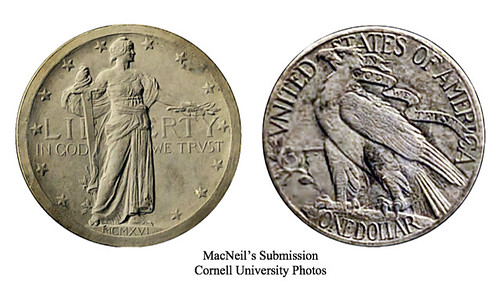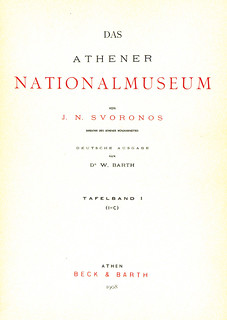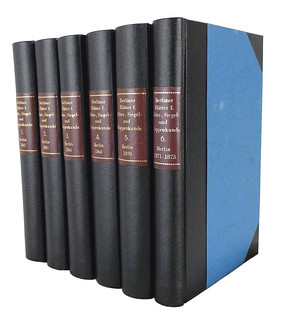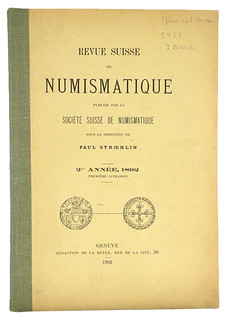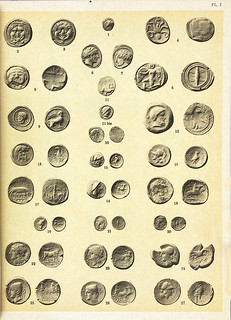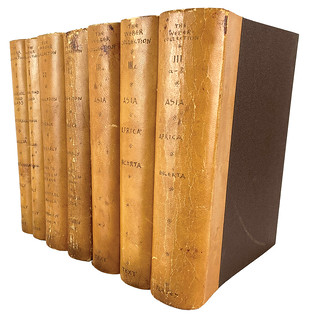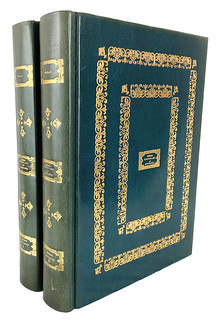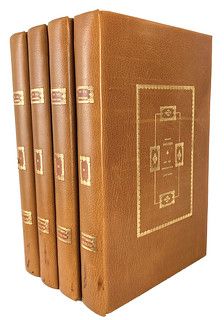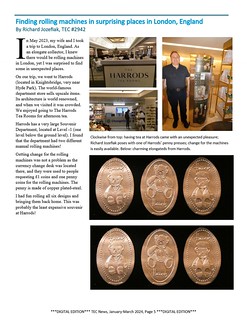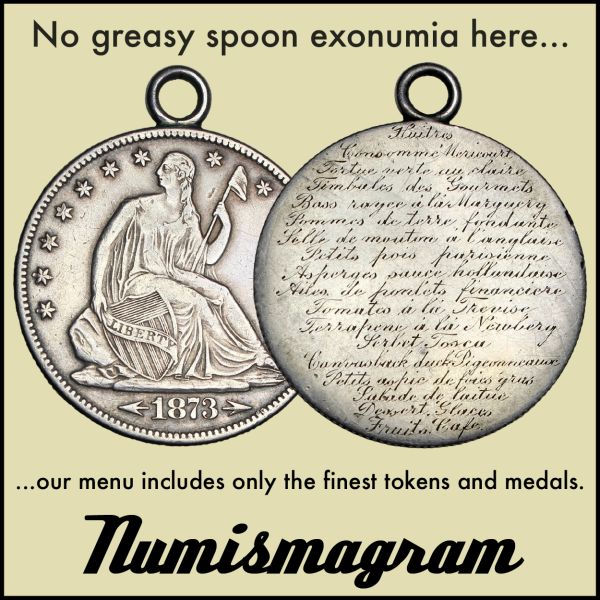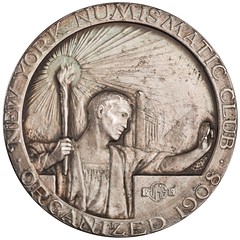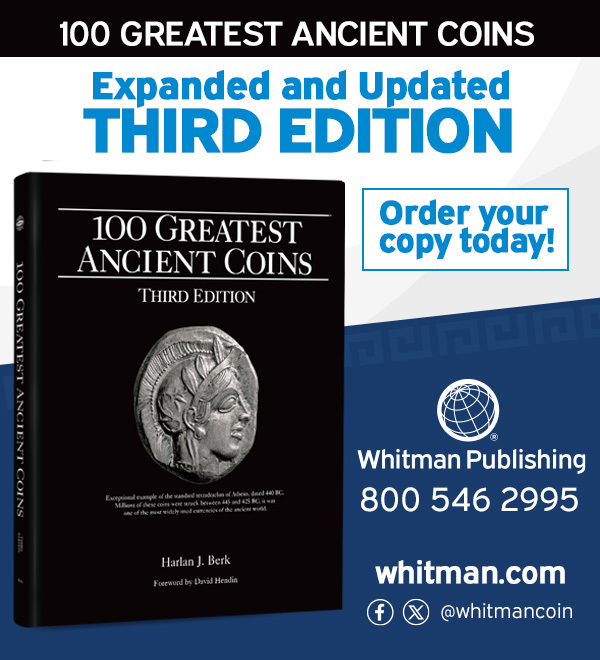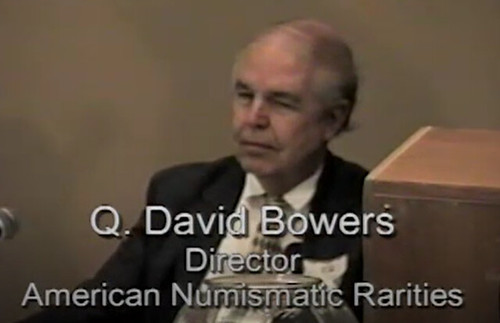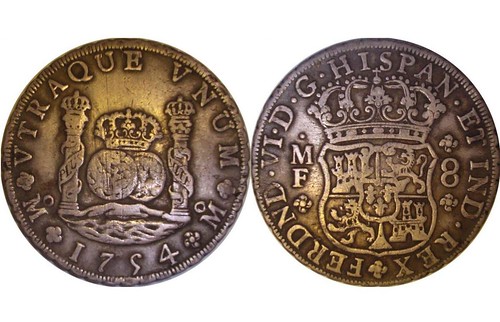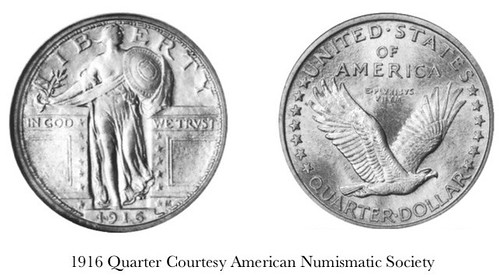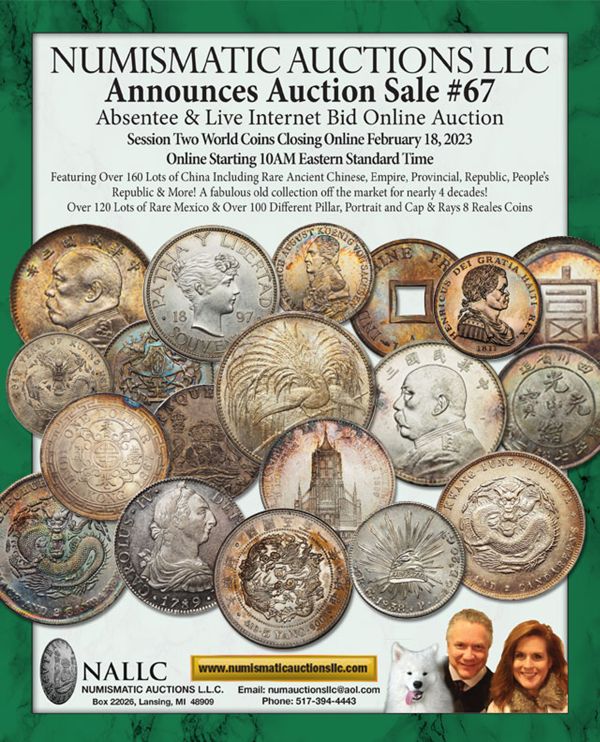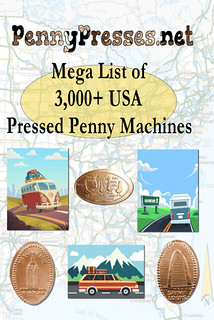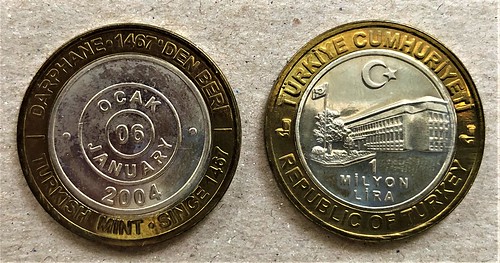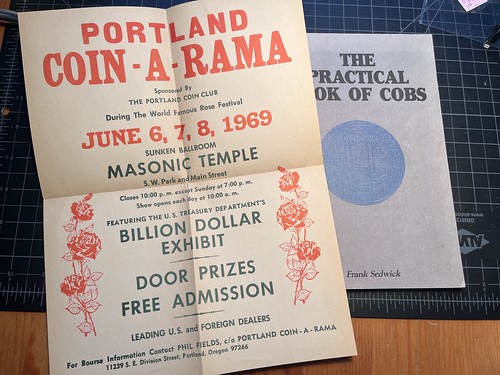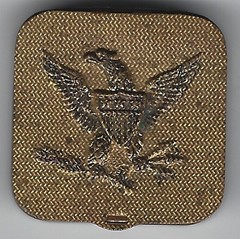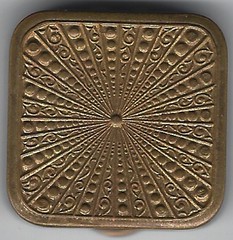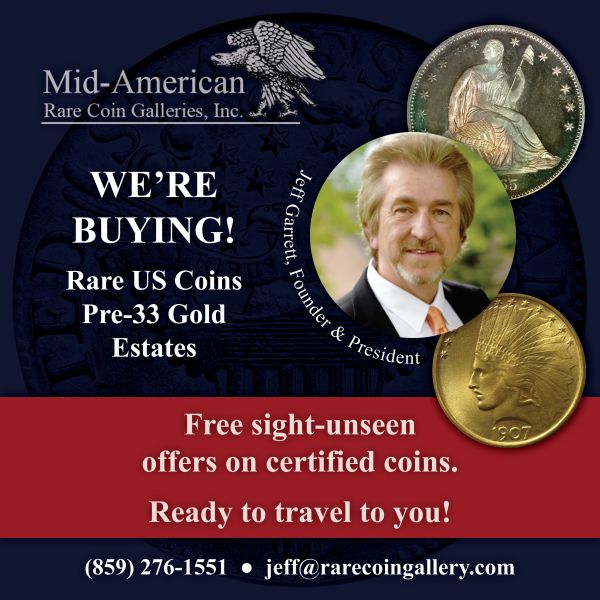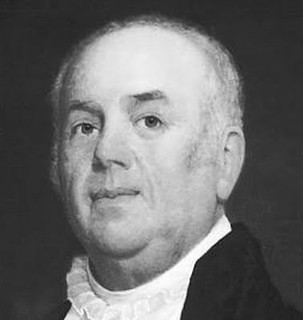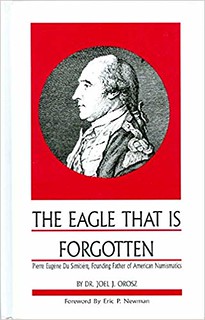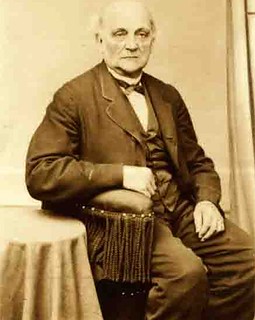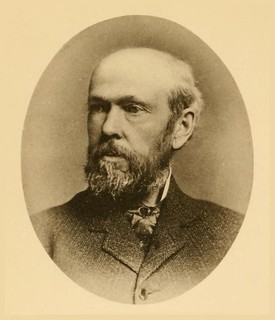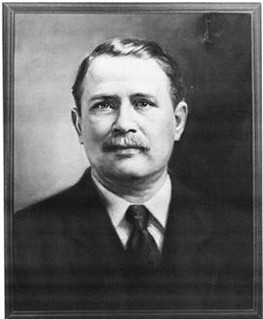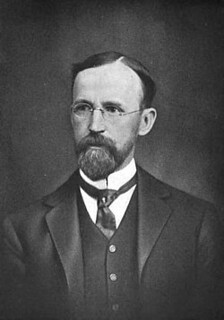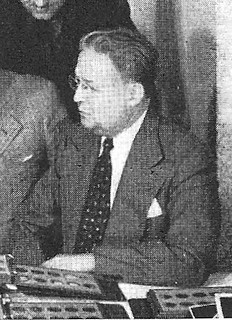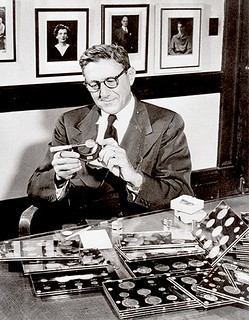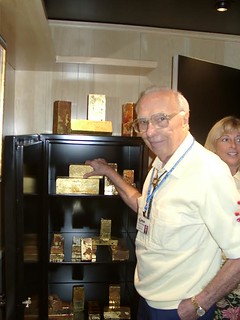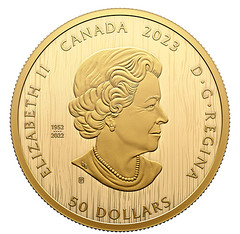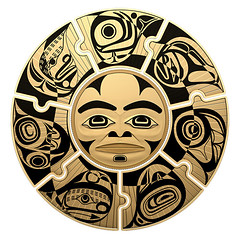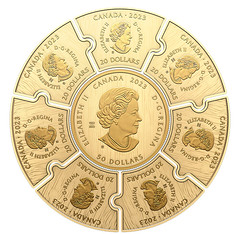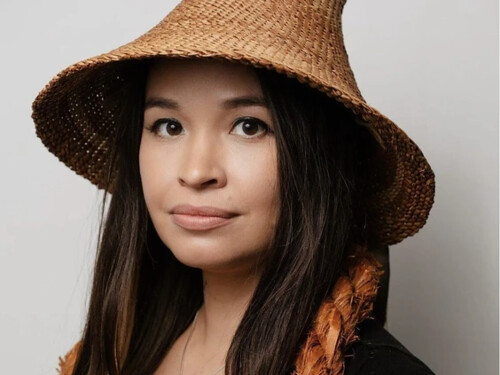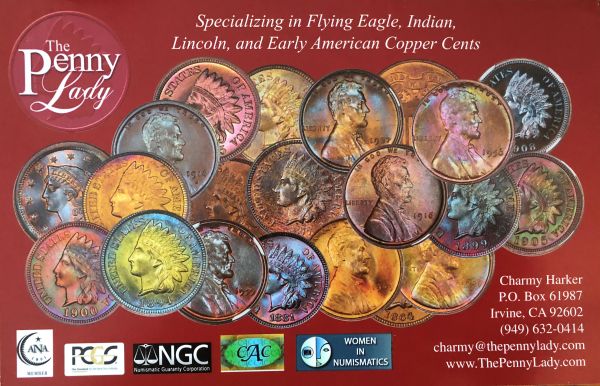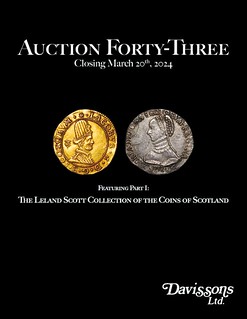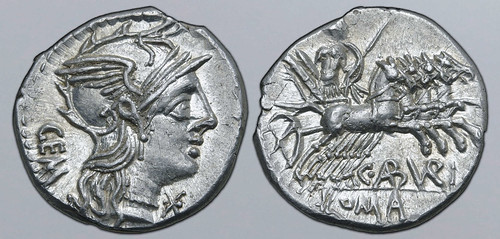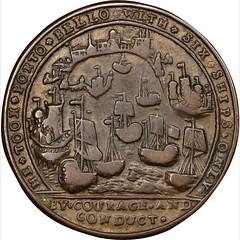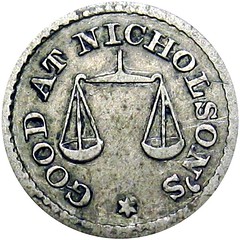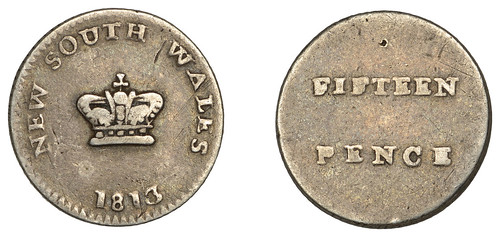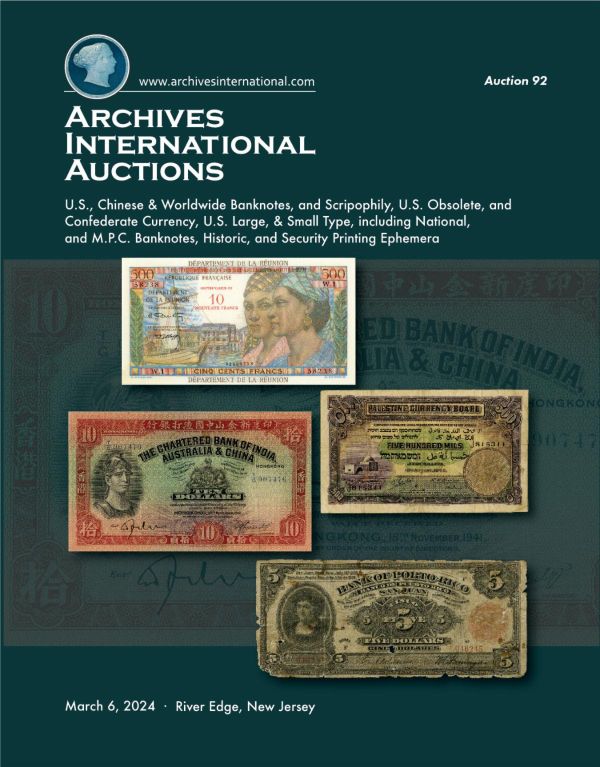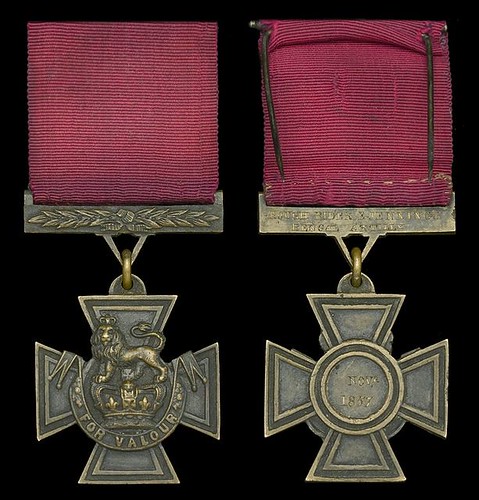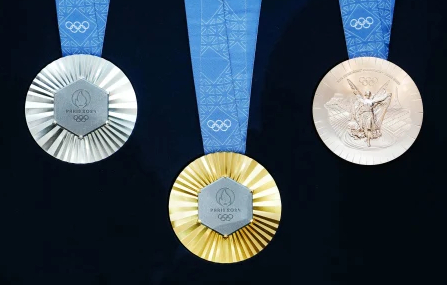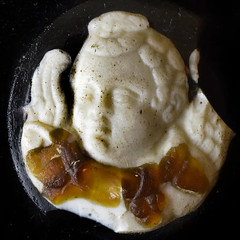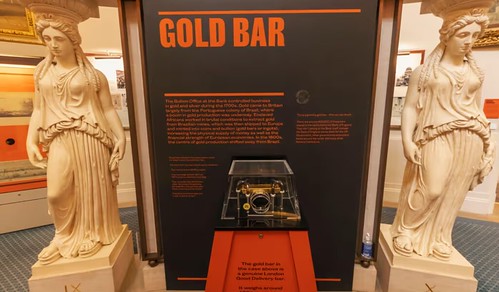
Visit our NBS Sponsors
About UsThe Numismatic Bibliomania Society is a non-profit association devoted to the study and enjoyment of numismatic literature. For more information please see our web site at coinbooks.org SubscriptionsThose wishing to become new E-Sylum subscribers (or wishing to Unsubscribe) can go to the following web page link MembershipThere is a membership application available on the web site Membership Application To join, print the application and return it with your check to the address printed on the application. Print/Digital membership is $40 to addresses in the U.S., and $60 elsewhere. A digital-only membership is available for $25. For those without web access, write to: Jeff Dickerson, Treasurer AsylumFor Asylum mailing address changes and other membership questions, contact Jeff at this email address: treasurer@coinbooks.org SubmissionsTo submit items for publication in The E-Sylum, write to the Editor at this address: whomren@gmail.com BUY THE BOOK BEFORE THE COINSale Calendar |
- WAYNE'S WORDS: THE E-SYLUM FEBRUARY 11, 2024
- MORE KOLBE & FANNING BCD LIBRARY HIGHLIGHTS
- NEW BOOK: A QUESTION OF VALUE
- NEW BOOK: COINAGE OF TELANGANA
- PERIODICAL: TEC NEWS, JANUARY-MARCH 2024
- PERIODICAL: NUMISMATIQUE ASIATIQUE NO. 48
- WHITMAN PUBLISHER DENNIS TUCKER RETIRING
- A NUMISMATIC VALENTINE
- VIDEO: EARLY DAYS IN THE COIN HOBBY
- MORE ON HAMILTON AND SILVER FINENESS
- MORE ON MACNEIL'S MODELS
- MORE ON THE APPLETON COLLECTION AT MHS
- NOTES FROM E-SYLUM READERS: FEBRUARY 11, 2024
- VOCABULARY TERM: PATTERN
- WHO HAD THE LARGEST COLLECTION IN THE U.S.?
- FRANCIS WAYNE GROVE (1909-1993)
- CELESTIAL CIRCLE COIN ARTIST MORGAN ASOYUF
- KEVIN FLYNN VARIETY AND ERROR COLLECTION
- DAVISSONS AUCTION 43 ANNOUNCED
- NUMISMATIC NUGGETS: FEBRUARY 11, 2024
- NEW SOUTH WALES FIFTEEN PENCE DUMP FOUND
- KLAWOCK, ALASKA TOKEN DISCOVERY
- AN ‘IRISH' VICTORIA CROSS
- 2024 PARIS OLYMPICS EIFFEL TOWER MEDALS
- LOOSE CHANGE: FEBRUARY 11, 2024
- BANK OF ENGLAND MUSEUM REVAMP ON HOLD
Content presented in The E-Sylum is not necessarily researched or independently fact-checked, and views expressed do not necessarily represent those of the Numismatic Bibliomania Society.
WAYNE'S WORDS: THE E-SYLUM FEBRUARY 11, 2024
 New subscribers this week include:
Greg Billman of the Northwest Coin Club, courtesy Pete Smith.
Welcome aboard! We now have 7,452 subscribers.
New subscribers this week include:
Greg Billman of the Northwest Coin Club, courtesy Pete Smith.
Welcome aboard! We now have 7,452 subscribers.
Thank you for reading The E-Sylum. If you enjoy it, please send me the email addresses of friends you think may enjoy it as well and I'll send them a subscription. Contact me at whomren@gmail.com anytime regarding your subscription, or questions, comments or suggestions about our content.
This week we open with a final group of highlights from the Kolbe & Fanning BCD numismatic literature sale, two new books, two new periodical issues, a retirement, updates from the Newman Numismatic Portal, notes from readers, and more.
Other topics this week include coinage of Telangana, the coin hobby in the 1950s, MacNeil's models, the Appleton collection, publisher Dennis Tucker, author Frank Grove, artist Morgan Asoyuf, auction previews, Alaska tokens, the 2024 Paris Olympics medals, and the Bank of England Museum.
To learn more about engraved gems from the collection of the Vatican, auctioneer Robert Brunk, author Daniel W. Valentine, the 1969 Portland Coin-A-Rama, Scottish coins, Nicholson's Half Dime, the Victoria Cross, a large cent found in a privy, and the GOINTOEM STRONG sale, read on. Have a great week, everyone!
Wayne Homren
Editor, The E-Sylum
MORE KOLBE & FANNING BCD LIBRARY HIGHLIGHTS
Here's a final group of highlights of the Kolbe & Fanning sale of the BCD Library, which closes Saturday, February 17, 2024. Don't forget to bid! -Editor
Kolbe & Fanning Numismatic Booksellers are looking forward to our first sale of highlights from the magnificent BCD Library on the coinage of antiquity on Saturday, February 17. The result of half a century of careful collecting, the BCD Library is known for the remarkable breadth and depth of its holdings, which focus most particularly on ancient Greek coinage. Our initial auction, which can be accessed at bid.numislit.com, includes an extraordinary offering of rare and desirable material.
Some highlights include:
Lot 43: J.N. Svoronos's rare periodically published work on the holdings of the National Archaeological Museum in Athens, Das Athener Nationalmuseum
Lot 92: a fine, complete set of the Berliner Blätter für Münz-, Siegel- und Wappenkunde (1862–1873), attractively bound in six volumes
Lot 120: a nearly complete set of the Revue suisse de numismatique / Schweizerische numismatische Rundschau (1891–2022)
Lot 202: an extremely rare 1859 photographic portfolio depicting coins, cameos and engraved gems from the collection of the Vatican and various museums in Rome
Lot 349: a complete set of Robert Jameson's catalogue of his exceptional collection of Greek and Roman coins, with 164 fine plates
Lot 359: Jean Babelon's well-produced and beautifully illustrated catalogue of the Duc de Luynes collection, complete in four volumes with 154 fine plates
Lot 398: the first editions (1789–1805) of Domenico Sestini's first eight volumes recording important European coin collections
Lot 418: Leonard Forrer's classic catalogue of the massive collection of Greek coins formed by Sir Hermann Weber, bound in seven volumes
Lot 419: Caronni's rare two-volume catalogue of the extensive collection of Greek and Roman coins formed by Hungarian Count Wiczay
Lot 580: four volumes from the impressive 1708 Antwerp edition of Goltzius, printed and illustrated in grand folio format.
Register early to bid online
Bids may be placed via post, email, phone, as well as online. Kolbe & Fanning use Auction Mobility as our third-party online bidding platform. Auction Mobility is an app-based platform allowing users the ability to participate in the sale through phones, tablets and computers. To register for the sale, bidders must go to
bid.numislit.com and sign up. Once you have set up an account, you may browse lots, place advance bids, or participate in the live sale online. Those wishing to participate on their devices can download the Kolbe & Fanning app through the Apple or Google Play Store. The sale has also been listed on Biddr and NumisBids.
To bid and view lots, see:
https://bid.numislit.com/
To view the catalogue PDF, see:
https://numislit.cdn.bibliopolis.com/images/upload/sale169-bcd-small.pdf
The printed catalogue has been mailed to all active customers on our mailing list. As international mail speeds have been inconsistent, we encourage our foreign clients to consult the electronic catalogue in case their printed catalogue does not arrive promptly. A PDF of the printed catalogue has been posted to our main website at numislit.com for those who prefer that format. Bids placed via post, email, or phone must be received by February 16, the day before the sale, in order for them to be processed. Advance absentee bids may also be placed at any time online at bid.numislit.com. Live internet bidding will be available during the sale itself through the same platform.
Kolbe & Fanning Numismatic Booksellers LLC is a licensed and bonded auction firm in the State of Ohio, and our sales are conducted by licensed auctioneers. For more information, please see the Kolbe & Fanning website at numislit.com or email David Fanning at df@numislit.com. To register for the sale, go to bid.numislit.com. We look forward to your participation.
To read the earlier E-Sylum article, see:
KOLBE & FANNING BCD LIBRARY SALE
(https://www.coinbooks.org/v27/esylum_v27n03a03.html)
KOLBE & FANNING BCD LIBRARY HIGHLIGHTS
(https://www.coinbooks.org/v27/esylum_v27n04a02.html)
MORE KOLBE & FANNING BCD LIBRARY HIGHLIGHTS
(https://www.coinbooks.org/v27/esylum_v27n05a02.html)
NEW BOOK: A QUESTION OF VALUE
Auctioneer Robert Brunk has written a book about his career. With a couple nice coins pictured on the cover, perhaps there are some numismatic stories within. -Editor
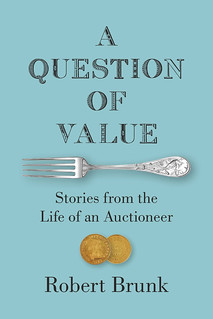 In the late 1970s, Robert Brunk discovered the world of auctioneering. Drawn to the unique mountain culture and the history of fine art in and around Asheville, North Carolina, Bob started a business, Brunk Auctions, that became part of a bustling network of commerce. America's passion for collecting, buying, and selling reached remarkable heights in the following decades. Auction houses and antiques stores thrived; people paid hundreds of dollars for a humble country basket and thousands for a rare piece of folk art.
In the late 1970s, Robert Brunk discovered the world of auctioneering. Drawn to the unique mountain culture and the history of fine art in and around Asheville, North Carolina, Bob started a business, Brunk Auctions, that became part of a bustling network of commerce. America's passion for collecting, buying, and selling reached remarkable heights in the following decades. Auction houses and antiques stores thrived; people paid hundreds of dollars for a humble country basket and thousands for a rare piece of folk art.
In this collection of compelling, compassionate essays, Bob considers specific items and remarkable situations he encountered in his long and successful work as an auctioneer and appraiser. He presents objects as invitations to consider personal and collective histories often related to unresolved social inequities. Bob also describes how, as his business grew to offer the finest examples of American and European art, his career often conflicted with his Mennonite background and the complexities of ownership and value. The result is a portrait that reflects the best and worst of us as we search for ways to live with objects—and then decide what to do when it's time to let them go.
You're invited!
Please join us to meet Robert Brunk, author of A Question of Value, Stories from the Life of an Auctioneer and founder of Brunk Auctions, have your book signed, and preview our upcoming auctions.
Book Signing and Auction Preview
Tuesday, March 5, 2024, 5:00 pm to 7:00 pm
117 Tunnel Road, Asheville, North Carolina
For more information, or to order, see:
https://bobbrunk.com/book/
NEW BOOK: COINAGE OF TELANGANA
A new book has been published on the coins of the Post-Mauryan and pre-Satavahana eras found in Telangana state of India. -Editor
Post Mauryan and Pre Satavahana Coinage and History of Telangana
Deme Raja Reddy (Author)
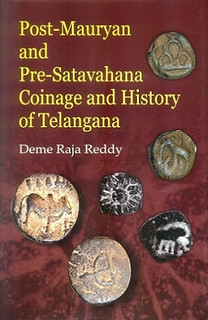 Though Telangana now happens to be the youngest and 29th state in India, it had been a distinct entity from ancient times.There were Greek references to AsmakaJanapada and Telangana by Megasthenese, Arrian, Pliny the Elder and Ptolemy. Ptolemy's Triglyphon and Trilinga corresponded to Telangana. First major family to rule this region was Asmakajanapada and it was succeeded successively by Nanda and Maurya dynasties. Most illustrious dynasty to rule this region next was Satavahana and their rule commenced in the later part of first century B.C.
Though Telangana now happens to be the youngest and 29th state in India, it had been a distinct entity from ancient times.There were Greek references to AsmakaJanapada and Telangana by Megasthenese, Arrian, Pliny the Elder and Ptolemy. Ptolemy's Triglyphon and Trilinga corresponded to Telangana. First major family to rule this region was Asmakajanapada and it was succeeded successively by Nanda and Maurya dynasties. Most illustrious dynasty to rule this region next was Satavahana and their rule commenced in the later part of first century B.C.
Post-Mauryan and Pre-Satavahana history of the Deccan which lasted about two hundred years is shrouded in darkness. Inscriptions and coins of that period reveal certain facts. After the disintegration of the Mauryan Empire some petty kings or local chieftains seemed to have assumed power in this region.
Names of kings such as Gobhada, Narana, Kamvayasa, Sirivayasa and Samagopa have come to light from the coins found at Kotalingala in Telangana region. Coins proved that the founder and the first king of Satavahana dynasty was Chimuka Satavahana and he succeeded the local king Samagopa. It came to be known that Chimuka was an official with the title Maharathi before he became a king. This book describes the coins of the Post-Mauryan and pre-Satavahana found in Telangana and it is an effort to bring to light the history of that era.
ABOUT THE AUTHOR
Professor Deme Raja Reddy is a renowned neurosurgeon and numismatist. He has published many books on Andhra coins.
For more information, or to order, see:
Post Mauryan and Pre Satavahana Coinage and History of Telangana
(https://www.bagchee.com/books/BB138077/post-mauryan-and-pre-satavahana-coinage-and-history-of-telangana)
PERIODICAL: TEC NEWS, JANUARY-MARCH 2024
The January-March 2024 (vol. 59, no. 1) issue of TEC News from The Elongated Collectors has been published. Here's the table of contents. -Editor
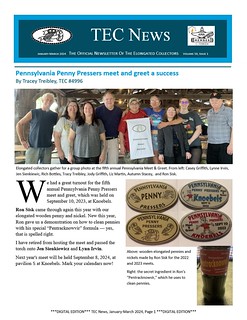 Pennsylvania Penny Pressers meet
and greet a success
Pennsylvania Penny Pressers meet
and greet a success
by Tracy
Treibly
Yerxa's now serves Hoffman House
coffee
by Alex Mruk
Finding rolling machines in
surprising places in London
England,
by Richard Jozefiak
A missing die ring is found (aka why
we need more databases!)
by Cindy
Calhoun
The Battle of Picacho Peak
by
Roger Rowell
Who painted the 1992 Wilkinson
holiday coins?
by Randy Kohler
2023 TEC coin design contest
theme: Join TEC
by Bob Frazier
Alternative host coins for pressed
pennies
by Justin DeCleene and Jim
McNally
Need help with initials
by Katie
Wanta
A cheap way to create elongated
coins, part 1
by Kian Breslin
Hanging with TEC members at the
WFoM in Pittsburgh
by Tim
Witucky
Departments
From the President
This issue's elongateds
From the Secretary
TEC store news
Trading Post Classifieds
From the Editor
For more information, or to join, see:
https://tecnews.org/
PERIODICAL: NUMISMATIQUE ASIATIQUE NO. 48
Here are the contents of the latest issue of Numismatique Asiatique. -Editor
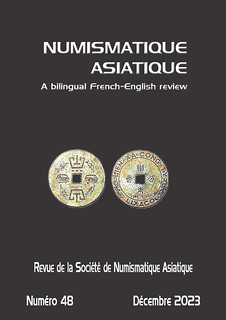 EDITORIAL
EDITORIAL
Les sapèques du Grand Nord
The sapeques of the Far North
CENTRAL ASIA
Offical seals of Western Liao inscribed in the Khitan Large Script
by V. A. Belyaev, S. V. Sidorovich
RUSSIAN FAR EAST
Tang Dynasty coins in medieval monetary circulation in Primorsky Krai
by Vladimir V. Pavlovskii
INDE FRANÇAISE
Deux notices relatives aux premières roupies de Pondichéry et aux faux de l'Inde française
by Daniel Cariou
EXTREME-ORIENT
De la sapèque à l'amulette, dans le monde sinisé ... et au-delà
by François Joyaux
Sommaires des n° 33 (Mars 2020) à 48 (Décembre 2023)
de Numismatique Asiatique
Série "Monnaies d'Asie"
65 pages en couleurs. Format A4 (21 x 29 cms)
For more information, or to order, see:
https://sites.google.com/site/societedenumismatiqueasiatique/revue
WHITMAN PUBLISHER DENNIS TUCKER RETIRING
After a long productive stretch at Whitman Publishing, familiar hobby figure Dennis Tucker is taking a well-deserved break. Here's the press release on his upcoming retirement. Hey - save me a rocking chair on the front porch of the Old Numismatists Home! -Editor
 Following a nineteen-year career as publisher
at Whitman Publishing, Dennis Tucker will retire at the end of February 2024. He plans to spend time with family in the United States and the Philippines while pursuing creative and philanthropic projects.
Following a nineteen-year career as publisher
at Whitman Publishing, Dennis Tucker will retire at the end of February 2024. He plans to spend time with family in the United States and the Philippines while pursuing creative and philanthropic projects.
Tucker has served Whitman as its publisher from December 2004, when the company was owned by Atlanta-based Anderson Press, through its recent acquisition by CDN Publishing. During that time, he has overseen the publication of more than 300 titles ranging from 64-page monographs to 1,504-page references in the fields of numismatics, banking and financial history, the American presidency, U.S. military history, and other nonfiction topics.
Dennis Tucker has been a loyal leader and a guiding figure in our business,
said Whitman president Mary Burleson. He has built lasting relationships with researchers and numismatic industry leaders, developed and mentored our editorial staff, worked as an advocate for readers and a partner for authors, and served as an ambassador to the numismatic community and non-collectors alike. I want to publicly thank Dennis for his dedication over a long and productive career.
Tucker has been part of the modern renaissance in numismatic publishing that started in 2003 with the addition of Q. David Bowers as Whitman's numismatic director. He helped develop more than two dozen volumes in the best-selling Bowers Series, as well as the popular 100 Greatest
library, many encyclopedic reference books, and twenty editions of the Red Book, which sold more than six million copies during his tenure.
An award-winning author himself, Tucker wrote the Whitman book American Gold and Silver: U.S. Mint Collector and Investor Coins and Medals, Bicentennial to Date (2016). He has written more than 400 articles published in commercial, scholarly, and popular numismatic journals and periodicals; given more than 40 numismatic presentations and lectures nationwide; taught courses at the American Numismatic Association's Summer Seminar at Colorado College; and been interviewed for hobby and mainstream media including NPR's Planet Money
and Morning Edition.
He has earned numerous hobby recognitions including the ANA's Glenn B. Smedley Memorial Award. In 2020 he was commissioned a Kentucky Colonel by Governor Andy Beshear for his career in publishing and for promoting the Commonwealth's numismatic history. In 2021 he was named by Coin World as one of the most influential people in numismatics from 1960 to 2020.
After his retirement Tucker will continue in various numismatic roles and activities, including
as secretary pro tem of the Rittenhouse Society, and as coauthor (with Coin World editor
Steve Roach) of the ANA's Collecting Friends
blog column. He will finish his second term
this year as numismatic specialist of the Treasury Department's Citizens Coinage Advisory
Committee, and he serves as chairman of the board of directors of Brayhope Farm, Inc., a
New York charitable nonprofit that offers community health and educational programs for
autistic children and others with physical, developmental, behavioral/emotional, and sensory
needs.
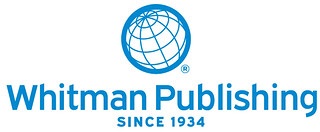
My time with Whitman has been a dream come true, one of the great pleasures in my life,
Tucker said. The people involved—collectors, dealers, researchers, writers, historians, and
co-workers—have made it a rich and fulfilling journey. I look forward to remaining active in
numismatics and keeping in touch with my many friends in and around the hobby.
With a heart full of gratitude and a legacy built with unwavering dedication, Dennis Tucker steps into retirement with immense pride, cherishing the memories created, and the impact made throughout an extraordinary career.
Good luck, Dennis! I'll look forward to continuing to interact in the numismatic realm. I know he'll have no trouble staying active and busy - he's not ready for the Old Numismatists Home yet. Here's an excerpt from a note he shared with fellow members of the Rittenhouse Society this week. -Editor
I'm retiring from Whitman Publishing at the end of this month. For a couple years I've been quietly working toward stepping down, in order to have more time for family and personal projects. Last year I took the first baby steps by scaling back to four days a week. Whitman's acquisition by CDN Publishing in October 2023 brought new opportunity to finally take the plunge. I'm confident in the company's new ownership (as I was with Anderson Presss), and I like what I see in the management and resources CDN brings to the table. My biggest reluctance in retiring came from uncertainty about executive/managerial succession, but I'm comfortable with the vision and commitment I've witnessed over the past few months, and I see great potential and bright horizons ahead.
I'm not physically going anywhere (I'll still be in Atlanta), and I plan on staying active in the hobby community, research, and writing. I'll be at the ANA show in March, and in August, and I look forward to seeing many of you in person, there and elsewhere.
As Dave Bowers often says, Onward and upward!
A NUMISMATIC VALENTINE
Newman Numismatic Portal Project Coordinator Len Augsburger provided the following report. -Editor
A Numismatic Valentine
Daniel W. Valentine, 1863-1932, is most remembered for his work on the United States half dime series, which culminated in the publication of The United States Half Dimes by the American Numismatic Society in 1931. This work represented the first substantive analysis of Liberty Seated half dime die varieties. Thomas Elder sold Valentine's collection in 1927, with the exception of the half dimes, which Valentine apparently retained at this point in preparation for publication. Valentine was honored by the New York Numismatic Club with a medal, commemorating his two terms as present of that organization beginning in 1918. Examples are scarce and this piece is among the keys in a set of New York Numismatic Club medals.
Images: The New York Numismatic Club David W. Valentine medal in silver (ANS collection no. 1985.67.544), images courtesy of American Numismatic Society.
Link to ANS / David W. Valentine correspondence:
https://archive.org/details/valentinedavidwd00amer
Link to video of Jerry Fochtman's 2018 presentation on Valentine:
https://archive.org/details/DrDanielValentineANumismaticPioneerbyJerryFochtman
Link to Thomas Elder's sale of the Valentine collection:
https://nnp.wustl.edu/library/auctionlots?AucCoId=23&AuctionId=513421
Link to CNG E-Auction 492, featuring the Jay Galst collection of New York Numismatic Club medals:
https://auctions.cngcoins.com/auctions/4-2FS4RH/electronic-auction-492
Link to CNG Feature Auction #117, featuring additional NYNC medals from Jay Galst:
https://auctions.cngcoins.com/auctions/4-28OZCU/cng-feature-auction-117?limit=48&search=new+york+numismatic+club
VIDEO: EARLY DAYS IN THE COIN HOBBY
The David Lisot Video Library on the Newman Numismatic Portal can be found at:
https://nnp.wustl.edu/library/multimediadetail/522852
We highlight one of his videos each week in The E-Sylum. Here's a great one from 2005 with a panel of luminaries trading stories of their early days in the hobby. Ron Guth MCs. -Editor
Professional Coin Grading Service Set Registry Meeting about the early days of numismatics with David Hall, Ron Guth, Art Kagin, & Julian Leidman. Speaker(s): David Hall.
To watch the complete video, see:
PCGS Set Registry Meeting 2005-Early Days in the Coin Hobby
(https://nnp.wustl.edu/library/book/560386)
MORE ON HAMILTON AND SILVER FINENESS
R.W. Julian submitted these notes on the fineness of the silver in early U.S. coinage and the exchange of U.S. silver dollars for Spanish dollars in the Caribbean. Thank you! -Editor
In the E-Sylum of February 4 Craig Sholley and Harry Salyards (S&S) reported that they were working on an article to refute one that appeared in the ANS Magazine of January 2024. The ANS article claimed that Alexander Hamilton, in his 1791 report on the coinage, had badly misjudged the situation and even the 15 to 1 ratio for silver to gold was wrong.
I also saw the ANS article and sent a note to the editor several weeks ago pointing out serious flaws.
S&S correctly note, using figures published by the 1878 monetary conference, that Hamilton did get the ratio right. The U.S. Mint Reports of later years, on the other hand, used the figures compiled by Dr. Adolph Soetbeer and these generally agree with the S&S report. (Soetbeer: 1789: 14.75 to 1, 1790: 15.04 to 1, 1791: 15.05 to 1, 1792: 15.17 to 1, 1793: 15 to 1, and 1794: 15.37 to 1. After 1794 the ratios were well above 15 to 1.)
S&S then discuss other topics, including the exchange (arbitrage) of U.S. silver dollars for Spanish dollars in the Caribbean. It has long been an article of faith that this was a common practice, the Spanish dollars being needed for the Orient trade.
S&S strongly doubt that the arbitrage was carried on to any extent and use the silver deposits at the Philadelphia Mint in the early 1800s to prove their point. However, S&S seem to be unaware of a flaw in this argument.
The main source for Spanish dollars in this country prior to 1806 was the Bank of the United States and it refused until 1805 to send these dollars to the Mint for recoinage. The reason for this was economic and had nothing to do with arbitrage.
The Bank rule about not depositing Spanish dollars was relaxed in November 1802 for a short time. Mint Director Elias Boudinot, as a result of an agreement with Bank president Thomas Willing, was allowed to draw on the Spanish dollars for personal deposits at the Mint; the last such deposit was made in July 1803.
One of these special deposits, of January 4, 1803, enables us to determine the specifics of Spanish dollars in a particular case. This deposit shows the average gross weight to be 415.72 grains, the fineness .893, and the pure silver content at 371.26 grains. (The U.S. dollar contained 371.25 grains of pure silver.) I have also seen other results which match the S&S figure of 372.4 grains
The special Bank rule about Spanish dollars was revoked in May 1805 as the result of an agreement between Director Boudinot and the Bank president. The revocation thus had nothing to do with the political and military events noted by S&S for October 1805.
One point not mentioned in the ANS article or by S&S is the fact that the actual fineness of U.S. gold coinage of the 1790s was .910, not the legal .916 2/3. It changed the ratio slightly and would have had some effect with European bullion dealers where better refining methods were available.
To read the earlier E-Sylum article, see:
ALEXANDER HAMILTON AND SILVER FINENESS
(https://www.coinbooks.org/v27/esylum_v27n05a12.html)
MORE ON MACNEIL'S MODELS
Jim Haas is the author of Hermon Atkins MacNeil: American Sculptor In the Broad, Bright Daylight. He submitted these thoughts on MacNeil and his model for the Standing Liberty Quarter. Thank you! -Editor
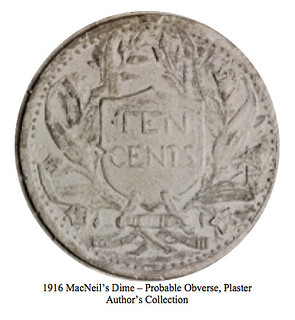 MacNeil was indeed a gifted sculptor, producing over 200 works in a career spanning fifty-plus years.
But he was also a very competent designer of not only the Quarter, his sole award, but let us not forget he was
one of eight sculptors invited to submit models for the Peace Dollar in 1921. Anthony de Francisci was awarded
the commission earning him $1,500; the other seven participants $100 for their entries. Bankers complained that
the coin would not stack, while others thought the coin to be unartistic. Relatively unknown until a decade prior,
MacNeil had also submitted a design for the ten-cent coin, the plaster of its reverse discovered by the family
that purchased their College Point home from his widow. This writer directed its owner to Stack's Bowers
resulting in its eventual sale.
MacNeil was indeed a gifted sculptor, producing over 200 works in a career spanning fifty-plus years.
But he was also a very competent designer of not only the Quarter, his sole award, but let us not forget he was
one of eight sculptors invited to submit models for the Peace Dollar in 1921. Anthony de Francisci was awarded
the commission earning him $1,500; the other seven participants $100 for their entries. Bankers complained that
the coin would not stack, while others thought the coin to be unartistic. Relatively unknown until a decade prior,
MacNeil had also submitted a design for the ten-cent coin, the plaster of its reverse discovered by the family
that purchased their College Point home from his widow. This writer directed its owner to Stack's Bowers
resulting in its eventual sale.
As E-Sylum readers know from my submissions, MacNeil was also a gifted medalist. He had excellent mentors and teachers one among them his uncle was Henry Mitchell of Boston. He along with St. Gaudens, who championed MacNeil's career, was charged in 1891 with selecting the new silver coinage from submitted designs. They found none that were deemed worthy and Charles E. Barber got the job. As acknowledged in The Controversial Quarter, MacNeil did study in Paris. In June 1888 after completing his second year of teaching at Cornell University, he took himself to Paris. There he studied under Michel-Marie-Antoine Chapu, one of France's foremost medalists and one of his favorite teachers. Chapu liked one of his sculptural works so much that he encouraged him to submit it to the salon of 1890.
Irene MacDowell was his first model for Miss Liberty; Doris Doscher was his second. Born in New Jersey in 1881, MacDowell's maiden name was Beer. Her father died in 1888 whereupon a year later her mother married William Weitling who in time moved his family to College Point, home of Hermon MacNeil. Irene married George I. MacDowell in April 1903 and the couple lived with her parents until moving, prior to 1915, to the village of Rock Tavern in upstate New York, Orange County.
MacNeil would have been well acquainted with William Weitling because by 1915, he had risen to the vice-presidency of the rubber firm founded by Conrad Poppenhusen at which time MacNeil was on the Board of Control of the Poppenhusen Institute an adult education school founded by Poppenhusen in 1868. William Weitling served along with him. According to newspaper notices, Irene would occasionally return to visit her parents in College Point, this making probable that on one of those visits she was MacNeil's model as was published in the reports of her death in 1973. It can only be assumed that with her work with MacNeil completed, she returned to her home in Rock Tavern with her daughter who was born in 1914.
It was not uncommon for a sculptor to make use of more than one model for a particular figure and for reasons known only to MacNeil, he focused on Doris Doscher. Perhaps it was because as he was quoted in an interview, She exemplified the highest form of American womanhood.
Logically speaking, the image of Liberty was a composite, but MacNeil never mentioned Irene MacDowell in any published articles.
At the time of her death, it was written that MacDowell had been both a model and actress. According to
a story published three months before her death she had been the model for the figure of Victory in Albany's
Soldiers and Sailors Memorial. The same had been said of Doscher. In the obituaries of both women their acting
careers were noted and that their husbands had been MacNeil's tennis partners, a sport at which Hermon
excelled. Between 1915 and 1917 his name appeared in newspaper articles reporting success in various
tournaments, but not that Messr's Doscher or MacDowell had ever played with or against him. Irene's husband
George was the son of a 19th century actor, Melbourne MacDowell, but for a variety of reasons, it appears he
had little to do with his father. One 1973 report said that her husband would not have approved of her being
either an actress or a model. In no reportage contemporary with the release of the Quarter was Irene MacDowell
ever referred to as the Liberty Girl. Doscher, however, was an actress as well as a model and was referred to in
various newspaper articles as the American Coin Girl and the
Girl on the Quarter.
One thing is for certain, MacNeil's Quarter remains one, if not the best, of America's most beautiful coins.
To read the earlier E-Sylum articles, see:
NEW BOOK: HERMON ATKINS MACNEIL
(https://www.coinbooks.org/v25/esylum_v25n43a02.html)
LOOSE CHANGE: FEBRUARY 4, 2024 : MacNeil's Standing Liberty Quarter
(https://www.coinbooks.org/v27/esylum_v27n05a25.html)
MORE ON THE APPLETON COLLECTION AT MHS
 There are some nuances to the story of William Sumner Appleton's collection at the Massachusetts Historical Society that Pete Smith and I wanted to point out on further reflection.
-Editor
There are some nuances to the story of William Sumner Appleton's collection at the Massachusetts Historical Society that Pete Smith and I wanted to point out on further reflection.
-Editor
In his initial article Pete wrote:
The Massachusetts Historical Society did not have adequate resources to provide security for
the coins and to make them available for research. Some had gone missing by 1920. Eventually
they put the coins in a bank vault where they were not available to anyone. The coins were
consigned to Stack's for a series of six auctions conducted over 1970 to 1976.
Pete's focus was on the sold coins, and that statement is correct. MHS curators Anne Bentley and Mary Yacovone also correctly noted that "most of the American colonial and later medals and NE silver coins collected by Appleton" are still in the society's collection. Parts of the collection were never consigned, and other lots were initially consigned but later withdrawn after catalog publication. -Editor
"In the Stack's sale of March 29, 1973, lots 1 through 105 were Colonial coins, including five Massachusetts silver coins. The prices realized indicates that lots 106-132 were withdrawn. That was a group of Betts medals. Also withdrawn were lots 151-186., which was a mixed group of medals. Fortunately, researchers can use the prices realized to see what was sold and what was withdrawn."
To read the earlier E-Sylum articles, see:
WILLIAM SUMNER APPLETON (1840-1903)
(https://www.coinbooks.org/v27/esylum_v27n04a17.html)
MORE ON WILLIAM SUMNER APPLETON
(https://www.coinbooks.org/v27/esylum_v27n05a13.html)
NOTES FROM E-SYLUM READERS: FEBRUARY 11, 2024
More on Custom Dansco Albums
Regarding custom Dansco albums,
Ken Barr writes:
"Phil Iverson beat me to the punch with his report on the California State Numismatic Association (CSNA) albums. I'm also aware of similar short-run productions for the San Jose Coin Club and the Fremont Coin Club, both also facilitated by Harvey Rose in El Cajon.
"I was actually in Harvey's shop while he was packing up the albums to ship to the Fremont club, and noticed a typo on the cover (it said "Organized 1921" instead of the correct 1971). Too late to fix, so they all went out that way. I was hoping to find examples of them to photograph, but have no idea as to where they are at present.
"I also have two examples of albums custom produced for the late L. A. dealer Charlie Rogers (C. T. Coins), titled "Casino Tokens" (or "Casino Chips"?) with Charlie's address label pasted over the DANSCO imprint on the inside back cover."
Thanks for the information! -Editor
Ken adds:
"For the record, the Charlie Rogers chips album just has "Chips" embossed on the cover and the spine, and includes nine pages with nine unlabeled ports each. My camera is currently Missing in Action so I'll send photos after I find it.
"Another FYI is that a similar album was prepared for the Santa Cruz Coin Club ... I've been a member since the 1980's but don't remember them ordering it. I bought one on eBay last week and should have it in hand shortly."
To read the earlier E-Sylum article, see:
NOTES FROM E-SYLUM READERS: FEBRUARY 4, 2024 : Dansco CSNA Medal Album
(https://www.coinbooks.org/v27/esylum_v27n05a14.html)
More on Pressed Pennies
Terri Ventresca writes:
"As Secretary of The Elongated Collectors, I want to thank you on behalf of our 780 members for giving a small shout-out for our beloved hobby. We don't get much publicity, so this was a nice surprise for me. Stuart Hockstein runs a very nice website and he facilitates a penny trade program that many children use. I'm sure he appreciates the story as well."
Stu Hockstein writes:
"I am the publisher of the book "Mega List of 3,000+ USA Pressed Penny Machines" which you featured in Volume 27, Number 05, February 4, 2024 of The E-Sylum. I just wanted to thank you for highlighting this book and for shining a light on our pressed penny collecting hobby. It is very much appreciated!
"I also wanted to let you know that the book is not out of print. You must have caught us in between pressings. We have a new batch ready and waiting still warm from the presses"
Great news - thanks. See last week's article (linked below) for ordering information. -Editor
Etienne le Pen writes:
"I particularly like the 'pressed coin machines' detailing the exact date of one's visit to an international mint, landmark or museum etc, like this Turkish Million Lira Coin....."
TURKEY BIMETALLIC 1 MILLION LIRA COIN of LAST YEAR of ISSUE 2004 (COMMEMORATING the 535th ANNIVERSARY of the TURKISH/OTTOMAN MINT in 2002) - CATALOG KM # 1139.2 / BRASS CENTER in COPPER NICKEL GOLDEN COLORED RING / 32 MM DIAMETER & WEIGHT of 12 GRAMS /
ALTHOUGH this COIN had FULL CIRCULATING VALUE at the TIME of ISSUE, the ONLY WAY to OBTAIN it was by VISITING the COIN STRIKING MACHINE at the TURKISH MINT in ISTANBUL (or the WORLD MONEY FAIR in BASEL), PAYING in YOUR 1 MILLION LIRA, PUSHING a BUTTON, and the COIN WOULD be STRUCK with the DATE of VISIT (in this case 6 JANUARY/OCAK in TURKISH 2004).
Thanks, everyone. -Editor
To read the earlier E-Sylum article, see:
NEW BOOK: USA PRESSED PENNY MACHINES
(https://www.coinbooks.org/v27/esylum_v27n05a06.html)
More on Gene Brandenburg
Bill Eckberg writes:
 "I, too, was saddened by Gene's passing. Living in Old Town I frequented his shop. Three coins I got from him were particularly interesting to me. The first was an uncirculated 1826 half cent (PCGS 63 in a rattler holder) that started me on building my half cent collections. The other two were definitely Old Town-related coins. One was an 1812 large cent that was found in a local privy and was quite rough from the exposure to human waste products over many years. It had been cleaned before I bought it. The other was an 1811 half cent that I still have. It has a square hole through it from having been nailed to a doorpost in Old Town.
"I, too, was saddened by Gene's passing. Living in Old Town I frequented his shop. Three coins I got from him were particularly interesting to me. The first was an uncirculated 1826 half cent (PCGS 63 in a rattler holder) that started me on building my half cent collections. The other two were definitely Old Town-related coins. One was an 1812 large cent that was found in a local privy and was quite rough from the exposure to human waste products over many years. It had been cleaned before I bought it. The other was an 1811 half cent that I still have. It has a square hole through it from having been nailed to a doorpost in Old Town.
"Gene could always be counted on to have something interesting in his shop, and in Nummis Nova, he always had something interesting to say."
Indeed. He is missed. Interesting coins, to say the least. -Editor
To read the earlier E-Sylum article, see:
GENE BRANDENBURG (1942-2024)
(https://www.coinbooks.org/v27/esylum_v27n05a09.html)
Portland Coin-A-Rama
Matt Ruttley writes:
"I was browsing through some E-Sylum newsletters from last year and remembered this piece of Rama-iana that popped up in a book a few years ago. There is a technical term for things that turn up in second-hand books - do you know it?
"I was at a coin show, perhaps the USMEX in Arizona and bought a second-hand copy of Frank Sedwick's Practical Book of Cobs. Inside was this wonderful folded up flyer/poster for the 1969 Portland Coin-A-Rama."
Matt copied Andy Newman as well; see the earlier article for background - Andy collects "all things using the suffix "rama" (a usage which began in England in 1789)." Thanks - great numismatic ephemera.
Andy responded with this article on "The Strange Things We Come Across in Second-Hand Books". -Editor
If you are a reader and buy old books, you'll know that the list is endless. Train tickets, theatre tickets, bills, receipts and bits of newspaper are the more frequent finds in second-hand books, but then there are also the rarer ones such as personal photos, dried leaves and flowers, maps, postcards, and even CDs. What does it feel like and what does it make one think, coming across in this way pieces from a stranger's life, distractedly pressed between the pages of a book that may not have been revisited much any longer, and so given away?
The very physicality of these errant items enables a sense of kinship – over both distance and time – brought about through the book, which then functions as a sort of vessel. In an old copy of Heat and Dust by Ruth Prawer Jhabwala, podcaster Laxmi Krishnan, 22, found an Indian Airlines boarding pass that was 13 years older than her, and she treasures it for that reason. I started thinking about who might have been reading this book all those years ago,
she says.
Aadil Desai, a 55-year-old manager service engineer at Air India Engineering Services and a veritable connoisseur of second-hand book finds, has a long, interesting list of things he has stumbled upon in old books: Dried leaves and flowers in a book on Troy, pocket calendars, old exam papers from college, prayer cards, museum brochures, art gallery exhibition inaugural invites, and even hotel key card holders. He tells me that he finds it sacrilegious to put things inside books since they may cause damage and spoil the pages, but treasures the items he himself chances upon. Just because someone forgot to remove them [the things] before disposing off their books doesn't mean I should throw them away,
he texts me, quite matter-of-factly. I treat all these items as an invaluable treasure to be preserved for posterity and not discarded even if the original owners did so knowingly or unwittingly.
To read the complete article, see:
The Strange Things We Come Across in Second-Hand Books
(https://thesoup.website/thelifedesk/2020/10/17/the-strange-things-we-come-across-in-second-hand-books)
To read the earlier E-Sylum article, see:
EVERYTHING-O-RAMA
(https://www.coinbooks.org/v26/esylum_v26n48a13.html)
Year of the Dragon!
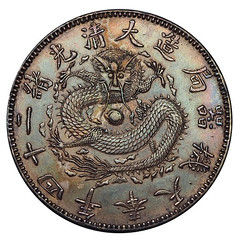 Jim Contursi writes:
Jim Contursi writes:
"With a great year of E-Sylum behind us, we're all looking forward to the coming year's issues.
"Wishing you and all your readers a healthy and prosperous Year of the Dragon! May we all catch the flaming numismatic pearl we are chasing."
Thanks. Speaking of dragons, the Croatian National Bank has issued bullion coins "inspired by the Trsat dragons, or basilisks." -Editor
To read the complete article, see:
Croatia: Bold and innovative designs feature Trsat dragon on new gold and silver bullion collector coins
(https://news.coinupdate.com/croatia-bold-and-innovative-designs-feature-trsat-dragon-on-new-gold-and-silver-bullion-collector-coins/)
To read the earlier E-Sylum article, see:
NUMISMATIC AUCTIONS SALE 67 WORLD HIGHLIGHTS
(https://www.coinbooks.org/v26/esylum_v26n05a20.html)
More on Coin Gift Holders
Bill Miller writes:
"Thanks for sharing the article about coin gift holders. For several years I've had one of these in my collection, not knowing what it was or its purpose. The interior is red plush with an indentation for a coin about the size of a five dollar gold piece. It is very similar, if not quite the same, as one of the holders shown in the article. I wonder if any of your readers would know how old a case like this one would be. I would guess mid-to-late 19th century."
Nice. Thoughts? Any more of these out there? -Editor
To read the earlier E-Sylum article, see:
COIN GIFT HOLDERS
(https://www.coinbooks.org/v27/esylum_v27n05a23.html)
George Ohr Works at the Kirkland Museum
Ted Puls writes:
"The Kirkland Museum in downtown Denver (near the Denver art museum) has six George Ohr clay coins in their display along with his pots (if I recall correctly the number). This amazing museum has many other quirky items that make it a must when I visit Denver. I can't think how his wife didn't do her job at restraining his purchases of stuff. This museum has many other just beautiful items too, including my other favorite - a room of Craftsman era furniture."
Thanks - that's good to know. I encourage readers to visit when in Denver. Here's an example of one of the Ohr pots in the Kirkland Museum collection. -Editor
 George Ohr, the self-styled
George Ohr, the self-styled Mad Potter of Biloxi
in Mississippi, created some of the most radical pottery of the Arts & Crafts period, throwing earthenware pots until they were as thin as eggshell porcelain, then folding and twisting them into unexpected shapes. I make disfigured pottery
, he said. Couldn't and wouldn't if I could make it any other way.
Ohr's multicolored and speckled glazes were another of the signatures that made his work stand out from other art pottery of the period. His credo was no two alike
. From the beginning of his career to its end, Ohr varied each piece of pottery in form or glaze to produce a large repertoire of unique work.
He rejected the mass-production of large Industrial-Age art potteries, as well as their division of labor between potters (who shaped the pottery), decorators (who glazed the pottery) and the designers or pottery owners who got most of the credit. All great orators, actors and artists MUST do their OWN WORK to score recognition
, he wrote. Ohr even went to the lengths of digging and processing his own clay from a pit he purchased near his studio. He made many more one-handled pots than two-handled. His handles are normally delicate tendrils that are more decorative than they are functional; this was Ohr's intention for his art pottery, which he considered more art
than pottery
.
To read the complete catalog entry, see:
Handled Vase
(https://www.kirklandmuseum.org/collections/work/handled-vase/)
To read the earlier E-Sylum article, see:
GEORGE OHR: THE MAD POTTER OF BILOXI
(https://www.coinbooks.org/v27/esylum_v27n05a21.html)
Pastimes We Hold So Dear
Jeff Dickerson writes:
"After reading through the latest edition of the E-Sylum, I was particularly struck by the words written by Frank S. Robinson concerning the sale of the BCD library. I suppose there is some small sample of us humans who are wistful and perhaps a bit classically romantic about the pastimes we hold so dear (be they numismatic, bibliophilic, or otherwise). I sympathize with those sentiments, but I am also reminded of the words written by Alfred Lord Tennyson in his Ulysses -
"One equal temper of heroic hearts,
Made weak by time and fate, but strong in will
To strive, to seek, to find, and not to yield."
To read the earlier E-Sylum article, see:
FRANK ROBINSON AND BCD
(https://www.coinbooks.org/v27/esylum_v27n05a03.html)
The GOINTOEM STRONG Sale
Dave Hirt writes:
"I enjoyed the polite auction post. I collect Elder sales, but my collection starts with his next sale, his 2nd.
"I have a sale something like that. It is Bangs & Co sale of 11/06/1873. The attendees arrived to find the material offered was so mediocre that it was a joke to them, A group of them decided to give the sale a humorous name. They named it GOINTOEM STRONG.
"Collecting numismatic literature is fun, although my wife says, Please Stop. You have too much."
To read the earlier E-Sylum article, see:
THE POLITEST AUCTION THAT EVER WAS HELD
(https://www.coinbooks.org/v27/esylum_v27n05a15.html)
VOCABULARY TERM: PATTERN
Here's another entry from Dick Johnson's Encyclopedia of Coin and Medal Terminology. -Editor
Pattern. A model from which something is made, usually in hard form. A pattern is required for modern die cutting operations, particularly for the die-engraving pantograph.
The purpose of the pattern is to convey the configuration of the surface, the design and lettering – it's modulated relief – to be cut into a die or formed into a mold. Die patterns used in a pantograph must be in a hard surface to sustain the tracking by the tracing stylus.
The artist's original model does not have to be in hard form, as this can be in wax, plaster or clay. If a cast medal is to be made, a model in any of these compositions is satisfactory. However, if the artist's original pattern is to be made into a die, this must be rendered into hard form. Formerly this was done by electrogalvanic casting (the result is called a galvano pattern), more recently by epoxy casting (called an epoxy pattern).
The galvano or epoxy pattern from this second stage is mounted on the die-engraving pantograph. At this stage it is still a pattern, but a better term is dieshell from which the die is reduced and cut (a dieshell is called a former in Great Britain).
If a pattern is used for several items (as the same design in several sizes, or different items) it is called a master pattern.
To read the complete entry on the Newman Numismatic Portal, see:
Pattern
(https://nnp.wustl.edu/library/dictionarydetail/517309)
WHO HAD THE LARGEST COLLECTION IN THE U.S.?
E-Sylum Feature Writer and American Numismatic Biographies author Pete Smith submitted this article on the largest numismatic collections formed in the United States. Thanks! Great topic. -Editor
I want to open a topic for discussion. Who had the largest American coin collection? I don't know the answer. Perhaps E-Sylum readers can reach a consensus over time.
Start with an obvious distinction, the difference between a collection and a hoard. A collection is a systematic grouping of different items with some common theme. A hoard includes multiple examples of the same things. An accumulation is just a bunch of stuff.
Along the way we should consider that different themes may include ancient coins, colonial coins, American coins, world coins, currency, medals and tokens. Within each of those may be legitimate subsets assembled as important collections worthy of mention.
I contacted Joel Orosz to get the discussion started. He reported that the earliest American coin collections were formed by colonial clergymen.
The Reverend Andrew Eliot (1718-1778) was pastor of the New North Church in Boston and not the Old North Church as stated in some numismatic references. He specialized in New England silver coins but little beyond that. He acquired coins from silversmiths and sent them to collectors in England.
Samuel Curwen (1715-1802) was a prosperous Salem merchant before the Revolution. As a
loyalist, he fled to England in 1775, returning to Salem in 1784. William Bentley described his
collection: This is the largest I have ever seen.
The Reverend William Bentley (1759-1819) of Salem mentioned coins in his diary. He wrote about the coins that passed through his hands but not the extent of his collection. He was an agent for the collection of James Winthrop.
Judge James Winthrop (1752-1821) of Cambridge was librarian at Harvard from 1772 to 1787. The extent of his collection is unknown.
John Andrews (1743-1822) was a Boston hardware merchant. His collection passed to his son Henry and was later acquired by the Massachusetts Historical Society.
Pierre Eugene Du Simitiere (1737-1784) had the first collection sold at auction in 1785. I don't think anyone knows the size of the collection but he had limited resources.
Robert Gilmor, Jr. (1774-1848) acquired some coins from Adam Eckfeldt at the Philadelphia Mint. His collection of American coins by date was nearly complete.
Joseph Mickley (1799-1878) has been called the father of American numismatics,
He lost a
large part of his collection to a burglary in 1867. The extent of his intact collection is unknown.
T. Harrison Garrett (1849-1888) had a collection described as second only to Parmelee. After his death in a sailing accident, the collection passed to his son Robert and then in 1919 to John Work Garrett and later to Johns Hopkins University. The collection was sold at auction for $25 million, a record at the time.
Byron Reed (1829-1891) donated his collection to the Omaha Public Library including 6395 coins, 474 patterns, 2136 U.S. notes, 607 Confederate bills and 1280 medals.
Lorin Parmelee (1827-1905) had a collection with an estimated value of $60,000 in 1883. When it was sold at auction in 1890, the sale realized $23,600.
John Story Jenks (1839-1923) had 11.000 coins which was a fine collection but dwarfed by the Brand collection of the same era.
Virgil Brand (1862-1926) was reported to have a collection of 350,000 coins. However, he had a lot of duplicates. His estate was passed to his two brothers, Armin and Horace.
Waldo Newcomer (1867-1934) had a collection described as the greatest coin collection never to have appeared at auction including about 4000 coins. Duplicates from his collection were sold by Mehl in 1914 and 1919. His pattern collection and world coins were sold at auction by J. C. Morgenthau.
Edward H. R. Green (1868-1936) had a collection that required eight armored trucks to transport it to the Chase Bank. Some of the collection was sold through dealer Burdette G. Johnson to Eric Newman.
Farran Zerbe (1871-1949) had a collection that was very large and diverse. It required more that a thousand trays to exhibit. The collection was seen by more than any other at the Chase Manhattan Bank Money Museum. Eventually the 25,000 piece coin collection was donated to the Smithsonian.
F. C. C. Boyd (1886-1958) had a collection advertised at the time it was sold as The World's
Greatest Collection.
His collection was strong in patterns. He donated 13,552 pieces to the
American Numismatic Society.
Louis Eliasberg (1896-1976) is the only collector to assemble a complete collection of United States coins. How many coins was that? His total collection included more than 10,000 pieces. Were there larger collections with more world coins?
John J. Ford. Jr. (1924-2005) had an incredible collection of colonial coins and American tokens and medals that included everything except United States Mint coinage.
Eric Newman (1911-2017) wrote the book on 1804 dollars but never owned one. His interest ran more to colonial coins and paper money than to more modern coinage.
Del Loy Hansen (1953- ) aspires to form a complete collection of American coins. He has not reported how close he is to completion in 2024.
Each of these collections has merits reflecting the interest of the collector. Collections were formed from what was available and interesting at the time. There is no common metric that can be used to establish quantity of coins or the value of a collection.
Ole Eklund (1873-1950) had more than 40,000 world copper coins which may have been the largest for that subset of coins. I suspect there have been larger collections of world coins in America that don't come to mind.
Amon Carter, Jr. (1919-1982) may have had the largest collection of world paper money. How many pieces was that? Who else had large collections?
My broad collection of tokens and medals exceeds 10,000 items. Within that are subsets that I believe are the largest of their kind. However, I suspect there are many larger token collections. Who had the largest collection of transportation tokens? How about Conder tokens, Civil War tokens, Good-for trade tokens? With the help of E-Sylum readers, I would like to answer those questions.
I know George and Melvin Fuld had a huge Civil War token collection, and Howard Gibbs amassed a huge collection of Odd and Curious money and acquired collections from Ole Eklund to boot. Please let us know what you think - How would you answer some of these questions? -Editor
To read the earlier E-Sylum articleS, see:
ANDREW ELLIOT, 18TH-CENTURY COIN MAVEN
(https://coinbooks.org/esylum_v03n38a09.html)
WILLIAM BENTLEY (1759-1819)
(https://www.coinbooks.org/esylum_v18n46a13.html)
OLDEST COIN COLLECTION RECORDED IN THE U.S.?
(https://www.coinbooks.org/esylum_v03n46a08.html)
REVIEW: DU SIMITIèRE AND HIS MUSEUM
(https://www.coinbooks.org/v23/esylum_v23n02a06.html)
ROBERT GILMOR, JR. (1774-1848)
(https://www.coinbooks.org/v20/esylum_v20n23a14.html)
LONG-LOST JOSEPH MICKLEY LETTER REDISCOVERED
(https://www.coinbooks.org/v20/esylum_v20n22a10.html)
BYRON REED (1829-1891)
(https://www.coinbooks.org/v26/esylum_v26n21a18.html)
VIRGIL BRAND ESTATE TOKENS AND MEDALS FOUND
(https://www.coinbooks.org/esylum_v19n04a09.html)
WALDO NEWCOMER (1867-1934)
(https://www.coinbooks.org/v24/esylum_v24n35a19.html)
JOSEPH FARRAN ZERBE (1871-1949)
(https://www.coinbooks.org/esylum_v19n13a13.html)
F.C.C. BOYD BIOGRAPHICAL DETAILS
(https://www.coinbooks.org/v24/esylum_v24n07a13.html)
LOUIS ELIASBERG, SR. AND JR.
(https://www.coinbooks.org/v24/esylum_v24n33a16.html)
WAYNE'S WORDS: THE E-SYLUM NOVEMBER 15, 2017
(https://www.coinbooks.org/v20/esylum_v20n47a01.html)
DELL LOY HANSEN SPEAKS ABOUT HIS COLLECTION
(https://www.coinbooks.org/v25/esylum_v25n14a05.html)
THE BOOK BAZARRE
FRANCIS WAYNE GROVE (1909-1993)
Last week Matt Ruttley shared news of his publication of a new edition of Frank Grove's Medals of Mexico. At my request, he kindly shared this short biography of Grove from the book. Thank you. -Editor
FrankWayne Grove
1909-1993
Frank Grove was born on April 8, 1909 in Carthage, Missouri. The family moved to California in 1920 where he attended school in the town of Ontario. In 1926 he enlisted in the U.S. Navy, serving for 30 years, including in the Korean War. Although the Navy based him in San Diego, he retired in 1957 to spend most of his time in Guadalajara, Mexico with his wife Josephine.
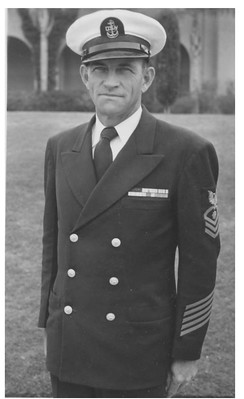 Their teenage step-children were given his Navy pension cheques and finished their schooling near their aunt and uncle, who ran an idyllic farm in the Californian countryside,
Their teenage step-children were given his Navy pension cheques and finished their schooling near their aunt and uncle, who ran an idyllic farm in the Californian countryside, filled with fragrant orange groves and walnut trees
. I was proud to call him dad
says his surviving stepson, Ron Weaver. Reminiscing about Frank, he recalls a fiercely intelligent and meticulous man, with a truly scientific mind. Everything numismatic was photographed, sketched and precisely measured. He also spoke fluent Japanese and studied stamps with as much rigor.
Grove spent nearly 30 years accumulating his collection, aided by many founding fathers
of the field including Clyde Hubbard and Miguel Muñoz. Truly avid, he would travel far and wide in pursuit of a photo, from tiny rural villages in Mexico to museums in Spain. No journey or eventuality was too much - a volcanic eruption in Costa Rica, an uprising in Panama were nothing - he simply hopped in the car. After 10 years in Mexico, he published his first book Medals of the Spanish Kings
, followed by two more about medals, one about Mexican Coins and finally Tokens.
The majority of Frank Grove's collection was sold in 1986 by Superior Galleries in Beverly Hills, CA.
To read the earlier E-Sylum article, see:
NEW BOOK: GROVE'S MEDALS OF MEXICO, 3RD ED.
(https://www.coinbooks.org/v27/esylum_v27n05a05.html)
CELESTIAL CIRCLE COIN ARTIST MORGAN ASOYUF
The Royal Canadian Mint's 2023 Celestial Circle puzzle coin was designed by Vancouver artist Morgan Asoyuf, who is profiled in this Vancouver Sun article. Here's an excerpt - see the complete article online. -Editor
Ts'msyen artist Morgan Asoyuf's 2023 Celestial Circle Royal Mint coin is all about the sun and the moon.
Containing both matte black and gold, Asoyuf said the coin represents diverse life cycles and their importance to traditions in the Northwest.
Asoyuf is an acclaimed artist who grew up on the North Coast and now lives in North Vancouver. She won a Mint design contest to put her art on the 2023 puzzle piece
collectible coin, which is 10 ounces and gold plated.
We called it the celestial circle because it's basically both the sun and the moon design in one,
she said.
The shapes of waves on the outside, which is sort of representing the duality like the moon cycle, the way that it affects the waves and our entire cycles of life.
The puzzle piece
coin contains depictions of the wolf, orca, raven and eagle Ts'msyen clans, with the sun and moon in the middle of the coin. Asoyuf is from the orca clan, and calls the Skeena her home, returning to the region every summer.
It's a coin that's got duality as a main theme, like the sun and the moon. Those are two huge things just as a human that affect our lives on a daily basis,
she said.
And in Northwest Coast art obviously we have a lot of focus on these cycles that affect our animals, our lives, our people; how we live with that. It's not just the Western idea of time.
To read the complete article, see:
Ts'msyen artist's design for gold coin celebrates life cycles and duality
(https://vancouversun.com/news/local-news/coin-designed-tsmsyen-artist)
For more information, or to order, see:
2023 Puzzle Coin Set – The Celestial Circle
(https://www.mint.ca/en-us/shopping/archives/2023/2023-puzzle-coin-set-the-celestial-circle-)
KEVIN FLYNN VARIETY AND ERROR COLLECTION
Author Kevin Flynn is selling a collection of error coins and varieties through Heritage. Here's the press release. -Editor
Currently Being Auctioned by Heritage
CONECA, the international error coin and variety club, announces that noted die variety and error specialist Kevin Flynn is selling the majority of his certified die varieties through Heritage Auctions. Included are nearly 580 lots including doubled dies, repunched mint marks, over mint marks, overdates, clashes, off-denomination clashes, repunched dates, misplaced dates, and other rarities.
Many of the coins for auction were used as plate coins for books that Mr. Flynn wrote. The auction listings include complete cross references, description, and where applicable, links to the die variety section of the book in which the variety was listed.
Denominations represented with examples of varieties include Indian Cents, Lincoln Cents, Two Cent pieces, Three Cent Nickels, Liberty Head Nickels, Buffalo Nickels, Barber Dimes, Quarters of different types, Walking Liberty, Franklin and Kennedy Half Dollars, and dollar coins including Liberty Seated, Trade, and Morgan Dollar. Gold varieties are also represented.
There are many varieties in the sale that have not been seen elsewhere. The collection is a
cumulation of thirty years of writing fifty-eight books and needing to find coins to use for those
books,
said Mr. Flynn.
He went on to say, Hopefully these coins might instill in others the hunt for additional possible
missing die varieties. It is so very satisfying seeing the cumulation of vast hours of searching, research,
and effort over these past years. The essence of our hobby is to gain and share knowledge.
This collection is highly significant for variety enthusiasts,
said James Motley, president of CONECA.
We anticipate that enthusiasm for the coins in this sale will fuel interest and education in the variety
side of our collecting hobby niche.
The thirty-day auction started 2/2/2024 and can be found here, listed as The Kevin Flynn
Collection of Die Varieties US Coins Showcase Auction #63270
:
https://coins.ha.com/c/search/results.zx?dept=1909&mode=live&auction_name=63270&ic5=Catalog
Home-ActionArea-BrowseAll-071515
For questions about variety coins, or this significant auction, please contact CONECA public relations via minterrors@gmail.com and we will put you in contact with Mr. Flynn. CONECA can be found online at https://conecaonline.org.
DAVISSONS AUCTION 43 ANNOUNCED
In an email to clients today, Allan Davisson announced his firm's upcoming auction sale. -Editor
Auction 43, closing Wednesday, March 20th 2024, is online now! Print copies will be mailed later this month, if you are not on our mailing list and would like a copy please let us know.
The first high quality, substantially pedigreed collection of Scottish coins to come to the market since the LaRiviere sale in 2006 begins in this, our major annual sale of some of the best coins we have come across in the past year. A beautiful and historic series with a fascinating array of designs typically reflecting the frequently changing winds of Scottish history are chronicled in a series that is a major departure in style and beauty from both the English and Irish coinage series.
Many of these pieces have important pedigrees. The Scottish series is small enough that high quality examples have often been important enough parts of the collections of others that they continue to carry this cachet. There have not been enough high grade Scottish pieces offered since LaRiviere to be able to cite equivalents for many of the pieces. I have relied on years of focus on Scottish material including personally marked catalogs from attending major sales, paying attention to the market and helping with building some major collections. Estimates are at the conservative end of the value range.
This collection will be offered over three sales—a major introduction to the collection with some of the most important pieces in the series featured in these pages. Our early June sale will focus on some of the less valuable coins in the collection. The grading standards for high quality for the rare pieces hold for the less valuable pieces in the series as well.
Then, early in the fall we will offer the last portion of the collection, again featuring some of the major rarities of the series—both gold and silver.
We have been fortunate with other consignments for this sale—Roman and Byzantine gold, English hammered and milled gold in addition to the Scottish material, and some historic US gold as well.
Our ancient offering is diverse and interesting. The Greek section includes many beautiful coins of superior style, for example the beautifully toned Kroton nomos with classic head of Hera Lakinia (lot 33). The Greek material ranges from fractions to tetradrachms and includes a small section (lots 43-47) from an old collection of pieces with old toning on fine quality flans and high aesthetic style tetradrachms of Alexander III from different mints. Continue on to some small rare denominations in exceptional condition. Then bronzes ranging from the Romans in North Africa to Spain move us into the interesting Roman Provincial (Greek Imperial) section.
A pleasing selection of beautifully toned Roman Republic denarii—largely from one old collection—follows. Imperatorial Rome is represented by the difficult and important denarius of Octavian celebrating his conquest of Egypt (lot 118) featuring the fearsome Nilus crocodile. A decent section of Roman Imperial follows, with many rare and unusual coins to appeal to collectors and condition-conscious buyers both. Military themes predominate. A pair of Byzantine coins precede the continuation of our offering of Robert Ready created British Museum electrotypes of the Museum's finest Greek coins. (MD)
Several lots of historic Anglo-Saxon electrotypes from the British Museum collection are offered next. They are rare, produced in very limited quantities. There is a note that begins this section that summarizes what I know about them.
A small and select collection of Carolingian coins follows this section. The Carolingian denier brought the flat and round coin with neat legends into circulation. The series also reflects French history and geography during the era with many cities and issuing authorities producing their own neat coinage.
We have been very fortunate to have a strong bloc of Anglo-Saxon pieces to offer again this year. In March 2023 we sold a major collection of coins from this era in one of the larger Anglo-Saxon offerings in recent years. While we cannot match the depth of that sale, the pieces offered here do match the quality and appeal. The English section continues on with hammered issues including a clear heavy halfpenny of Henry IV, a groat of Richard III, an appealing shilling of Philip and Mary, and a bit of milled coinage.
The Scottish section is next and a few Anglo-Gallic pieces follow.
The 18th century trade token section includes rarities and unusual pieces that have been held specially for this sale. The sale last year of the Deane Collection in London achieved remarkable prices on almost everything. (It also sold substantially to one client.) The estimates in this sale are conservative and, in a fair number of cases, below what someone paid initially for the piece.
A select sampling of world coins follows, representing a wide range of times and places including a particularly attractive example of the China Republic junk dollar with wild geese flying toward a rising sun. The authentication/grading service graded it AU cleaned.
If you have access to images of other examples of this issue, look at them on your computer screen and then look at this one. Whatever the cleaning, this coin has a particular freshness and appeal that many others do not. (It is amazing to be able to see so much so easily in this internet age—as someone who began in business long before such ready access really appreciates.)
A small selection of coins from the USA's colonial era provides a succinct introduction to the importance of English counterfeit currency to American trade. This has become an important area for US colonial scholars and collectors.
The sale ends with a mix of US material—some choice classic commemorative pieces, another rare Lincoln Emancipation Proclamation Medal (we had one in our sale last year that was a factor in our getting this consignment for this sale), and a few important and attractive historic medals.
Assembling all this has been both a challenge and a pleasure, and we hope that you enjoy it as well and find some pieces to enhance your own collection.
To browse the online and print catalogs, see:
https://davcoin.com/sale/Printed%20Auction%2043
https://davcoin.com/pdf-viewer/49589
NUMISMATIC NUGGETS: FEBRUARY 11, 2024
Here's a selection of interesting or unusual items I came across in the marketplace this week. Tell us what you think of some of these. -Editor
Aburius Geminus Denarius
C. Aburius Geminus AR Denarius. Rome, 134 BC. Helmeted head of Roma to right; GEM behind, mark of value below chin / Mars driving quadriga to right holding sceptre, shield, reins and trophy; C•ABVRI (partially ligate) below, ROMA in exergue. Crawford 244/1; BMCRR Rome 999; RSC Aburia 1. 3.93g, 18mm, 2h.
Lot 775 in the Roma Numismatics E-Sale 117. -Editor
To read the complete lot description, see:
C. Aburius Geminus AR Denarius.
(https://romanumismatics.com/284-lot-775-c-aburius-geminus-ar-denarius?auction_id=185&view=lot_detail)
Admiral Vernon Medal Love Token
Love token fashioned out of an undated Adams-Chao PBv 25-U Admiral Vernon medal. Pinchbeck. Host medal Fine.
37.5 mm. 229.0 grains. The obverse has been skillfully engraved with *** / POLLEY / *1790* in the left field, ** / JOHNSON in the right field, and another expression of the date 1790 before and over the bottom of Vernon's portrait. An additional engraved * can also be discerned on Vernon's chest.
Provenance: From the Sydney F. Martin Collection. Purchased from David Fanning, December 2010.
Can't say I've ever seen or heard of a love token on an Admiral Vernon medal. From the Stack's Bowers -Editor
To read the complete lot description, see:
Love token fashioned out of an undated Adams-Chao PBv 25-U Admiral Vernon medal. Pinchbeck. Host medal Fine.
(https://auctions.stacksbowers.com/lots/view/3-17U95E/love-token-fashioned-out-of-an-undated-adams-chao-pbv-25-u-admiral-vernon-medal-pinchbeck-host-medal-fine)
Nicholson's Half Dime
Pre Civil War 1850's token Miller / Rulau MO 24 EF with a few light, short scratches. Good At Nicholson's. State Of Missouri Half Dime with image of scales on obverse (100-125).
Interesting token from Steve Hayden's eBay offerings. -Editor
To read the complete lot description, see:
1850's St. Louis Missouri Merchant Token Nicholson's Half Dime Scales
(https://www.ebay.com/itm/225983049163)
NEW SOUTH WALES FIFTEEN PENCE DUMP FOUND
In the better-late-than-never department, here's a Noonan's press release that didn't make it into last week's issue - the piece has already been sold. Great find, though. -Editor
Oxfam Volunteer and coin enthusiast John Turner was looking through a bag of coins that had been donated to Oxfam's shop in Orpington when he spotted what he thought could be a rare coin. It was taken to Noonans Mayfair for a second opinion where it was confirmed that it was an Australian New South Wales Fifteen Pence or Dump dating from 1813. It is estimated to fetched £5,000-7,000 and will be offered in a two-day sale of Coins and Historical Medals on Tuesday and Wednesday, February 6 and 7, 2024.
John who is in his mid 70s, has volunteered for Oxfam for the past 10 years since he retired from banking. He lives in Bromley area and is based at his local Bromley shop in South East London, however there are 8-9 shops in South London that he visits regularly.
He explained: I started collecting British coins when I was a teenager (some time ago now!) and more latterly also British Empire money, so I had some knowledge to build on; but I have learned a lot from volunteering!
He added: In April 2023 I was invited to sort some donations of loose material in bags at the Orpington shop. On a cursory examination, these appeared to be largely what I would describe as ‘holiday money', with some, but little or no collectable value. Having sorted the ‘easy' items into various categories, and priced a few items requiring some look up, I was left with a small silver-grey coloured item I had never seen before, inscribed New South Wales 1813 Fifteen Pence. Using the internet as my first line of enquiry, I found two such items that had sold for between £30 and £50, described as ‘most likely Becker copies'. Not a value to be ignored, but a copy of what?
After considerable online investigation, John revealed the story of how the Governor of the New South Wales Penal Colony commissioned a reformed forger, who had been transported from England, to make coins for local circulation from 40,000 Spanish silver ‘pieces of eight', by punching out the centres (to form the dump), the outside coin forming ‘holey' dollars, and counterstamping them with NSW inscriptions. These were then Australia's first coins, before Australia was officially formed as a country. Opinion seemed to be that only around 1,000 of each coin still existed, the majority having been melted down in the 1840s.
He continued: Searches of auction site results, mainly in Australia, but some UK, showed a wide variety of realised, prices, but one UK site showed a sale of over £2,000 for a ‘rough' example (not a numismatic term, but meaning one in significantly poorer condition than ours). Australian results were considerably higher. My guess was that IF the coin was genuine (a very big if!) it might be worth at least £5,000. However, this was well beyond my competence to judge, and given how it turned up, made it somehow unlikely. The bags from Orpington had not been marked as eligible for Gift Aid, meaning that there was no way of tracing the donor.
After this research, I told the Orpington Deputy Manager that we should tell the Area Manager potentially what we might have. This eventually led to Oxfam referring the coin to Noonans, who were able to confirm the coin as genuine.
He finished by adding: It is brilliant to know the money raised from the coin will go towards Oxfam's much-needed work to tackle poverty around the world.
As Shelley Hitch, Valuer at Oxfam added: The Orpington area manager passed the coin to me as she knew I had a relationship with several auction houses and Noonans kindly don't charge Oxfam any commission. Volunteers like John are so valuable to Oxfam, and this is a great discovery. It means even more to know that the money raised will go towards vital funds to help tackle poverty across the globe.
Tim Wilkes, Head of Coin Department at Noonans also commented: The market for these early Australian pieces is very strong and we hope that this piece will do well.
To visit the Noonan's website, see:
https://www.noonans.co.uk/
KLAWOCK, ALASKA TOKEN DISCOVERY
With permission, we're republishing this article on a recent eBay find of a rare Alaska token from the February 2024 issue of The Alaskan Token Collector & Polar Numismatist edited by Dick Hanscom. Artificial intelligence has a hand in this one. -Editor
PREDICTEDBY 1908 NEWS ARTICLE!
Alaska Sentinel, Wrangell, November 26, 1908.
NOTICE
All persons having any of the aluminum checks issued by the North Pacific Trading and Packing Company of Klawock, Alaska, are hereby notified to send or present same to the office of this company at
Klawock for redemption before January 1, 1909,
as no more of these checks will be issued.
H.F Swift, Supt.
The above news article was reported in the October, 2023 issue of this newsletter. This token sold in December 2023 on eBay for $915. The token is aluminum, 34.2mm in diameter.
Dick notes, "Previously, the only tokens known were brass. This made the calling in of the aluminum tokens more interesting." -Editor
J.D. Williams called this to my attention. I had not seen it on eBay, for reasons that will become apparent.
Whenever a newly discovered token appears, my paranoid side blares out warnings. I look for reasons that it is legitimate, or possibly a fake or fabrication.
The token has the same error as the 50¢ brass, showing the abbreviated company name as N.P.T&P.OOS., so my first thought was they used the same punch. But the 50¢ is good for merchandise, but the newly discovered $1 is good for coin!
Now, I say punch because all the lettering is incuse. It would make more sense for a punch to be used rather than a die.
As to the denomination side, the lettering looks the same on the square brass $1 and the newly discovered round $1 aluminum.
J.D. Williams notes what he sees as differences (see
the large illustration on the next page): the second parallel line in the $ sign looks longer and the base of the
dollar sign and continuation dashes look thicker. And
perhaps the curve up in the bottom of the S in Alaska is
different although maybe that is only a matter of lighting.
The comment on the $ sign might be there, but I am seeing the same angle coming off the top of the S. As to the other differences, I think they can be attributed to wear. The square brass $1 is a well used token.
The only way to know for certain is to have images that could be superimposed to see how the lettering lines up.
Now as to this possibly being a fabrication, J.D. said he found the lot description suspect. I had not paid much attention to it, but went back and re-read it.
This vintage aluminum coin is a unique item to add
to your collection. The coin features the design of
the KLAWOCK Store and has a value of $1.00. With
a diameter of 1 1/2 inches, it is a great souvenir to
remind you of your visit to Alaska or to add to your
Commissary Coin collection. This item was made in
the United States and is a great addition for any
collector.
I had to laugh. Recently when I was putting some coins on eBay, I was offered the opportunity to let AI write the description. It was horrible. It is apparent that the seller used this option and let AI describe the token. The seller listed this in Collectibles & Art > Souvenirs & travel memorabilia > U.S. > Alaska. So that is where AI got the idea of a souvenir and reminder!
The seller states that the token was from his father's collection and that there was only one. The seller dabbles in tokens and this was the only Alaska token offered at this time. The majority of his offerings are collectibles. A listing under collectibles most likely resulted in it not being seen by as many Alaska token collectors as possible.
A saltery was established at Klawock about 1869 by George Hamilton. He sold his trading and fishing post in 1876. The North Pacific Trading & Packing Co. was incorporated under the laws of California in 1877.
The 45-year index to The Alaskan Token Collector & Polar Numismatist has just been published, covering the years 1979 to 2023. Wow! -Editor
For more information, or to subscribe, contact Dick at: alaskararecoins@gmail.com .
AN ‘IRISH' VICTORIA CROSS
The Victoria Cross and other medals awared to Irish mounted soldier Edmond Jennings will be sold tis week at Noonan's. -Editor
A Victoria Cross awarded to Edmond (Edward) Jennings of Ballinrobe, Co Mayo, is going under the hammer at Noonan's in London on February 14.
The British military medal is awarded for acts of the greatest heroism or of the most conspicuous courage in circumstances of extreme danger
.
Jennings was a Rough Rider (mounted soldier) in the Bengal Horse Artillery during the Relief of Lucknow, 1857.
The medal is estimated to fetch £20,000 to £30,000 (€23,368 to €35,052).
In recent years, Irish Victoria Crosses have done extraordinarily well at auction.
 Jennings... melted into obscurity. He ended his days as a
Jennings... melted into obscurity. He ended his days as a corporation scavenger
or road sweeper in North Shields, England, and was buried in a pauper's grave.
Edmond Jennings was awarded the Victoria Cross once, but there are two medals carrying his name.
The most likely explanation is that Jennings' medal was sent out to India, along with the other Bengal Artillery Victoria Crosses, and presented to him there.
Queen Victoria wished to decorate him in person at a ceremony in Windsor in 1860 and another cross was made, but Jennings' ship was delayed and he failed to turn up.
At some stage, having fallen on hard times, Jennings sold his military medals and these found their way back to his regiment.
Since the Victoria Cross was introduced in 1856, there have been around 200 Irish recipients — 59 of these were awarded for actions during the Indian mutiny of 1857.
To read the complete article, see:
Mounted soldier's ‘Irish' Victoria Cross estimated to sell for €35,000 at auction
(https://www.independent.ie/life/home-garden/mounted-soldiers-irish-victoria-cross-estimated-to-sell-for-35000-at-auction/a1842375958.html)
2024 PARIS OLYMPICS EIFFEL TOWER MEDALS
A relic medal is one made from or with material from the item being commemorated. Medals for the 2024 Paris Olympic will contain a piece of the iconic Eiffel Tower. -Editor
An Olympic medal inlaid with a piece of the Eiffel Tower. How's that for a monumental prize?
A hexagonal, polished chunk of iron taken from the iconic landmark is being embedded in each gold, silver and bronze medal that will be hung around athletes' necks at the July 26-Aug. 11 Paris Games and Paralympics that follow.
Games organizers revealed their revolutionary design on Thursday.
By making history at the Games, Paris medalists will take a bit of France and its history home, too.
Built for the 1889 World's Fair — which celebrated the 100th anniversary of the French Revolution — engineer Gustave Eiffel's tower was only intended to stand for 20 years.
Instead, it just goes on and on — thanks to a bit of rejuvenating surgery from time to time and constant care. The 135-year-old tower is a veteran of two previous Games — in 1900 and 1924, the last held in Paris.
The iron pieces embedded in the center of the Olympic medals each weigh 18 grams (about two-thirds of an ounce).
They were cut from girders and other bits that were swapped out of the Eiffel Tower during renovations and stored for safekeeping, according to Joachim Roncin, head of design at the Paris Games organizing committee.
"The concept came after a few discussions. We realized that there's one symbol known across the world, which is the Eiffel Tower," Roncin said. "We said to ourselves, 'Hey, what if we approached the Eiffel Tower Operating Co. to see if it's possible to get a bit of the Eiffel Tower to integrate into the medal?'"
They were stripped of paint, polished and varnished for their second life.
They are stamped with "Paris 2024" and the Games logo — which looks like a flame or the face of a woman with a chic bob haircut. The five Olympic rings are also stamped on the iron of the Olympic medals. The Paralympic logo of three swooshes, known as the Agitos, is stamped on the medals for the Aug. 28-Sept. 8 Paralympics.
The iron pieces' hexagonal form represents France. The French sometimes refer to their country as "L'Hexagone" — the hexagon — because of its shape.
Paris jewelry house Chaumet designed the medals. Six small clasps that hold the iron pieces in the medals are a wink at the 2.5 million rivets that bind the Eiffel Tower together.
Around the iron pieces are disks of gold, silver or bronze. They're crinkled to reflect the light, making the medals shine. Games organizers say the metal is all recycled, not newly mined.
To read the complete articles, see:
The Paris Olympics medals will have pieces of the Eiffel Tower
(https://www.npr.org/2024/02/09/1230330335/paris-olympics-medals-eiffel-tower)
Paris Olympics medals are monumental: They're embedded with pieces of the Eiffel Tower
(https://www.nbcnews.com/news/world/paris-olympics-medals-eiffel-tower-rcna137855)
LOOSE CHANGE: FEBRUARY 11, 2024
Here are some additional items in the media this week that may be of interest. -Editor
The British Museum will put on display some of the stolen items it recently recovered for its collection. Although coins are among the stolen items, this exhibit focuses on the related area of Roman gems. -Editor
The British Museum will put 10 items stolen from its collection on show later this month.
The Roman gems, to be featured in an exhibition Rediscovering Gems, include a cameo with a bust of Cupid from the 1st or 2nd Century AD.
In August, the museum announced up to 2,000 objects from its storerooms were missing, stolen or damaged.
It has recovered about 350 items to date.
The exhibition will explore the significance of classical gems through history.
The museum has released pictures of two of those gems that have been chosen for display.
Both were returned by Dr Ittai Gradel, the dealer and collector who alerted the British museum to the thefts, and was originally brushed off.
Dr Gradel told the BBC he had been "delighted" to work with the museum on the recovery process.
To read the complete article, see:
British Museum to put stolen items from its collection on show
(https://www.bbc.com/news/entertainment-arts-68165171)
To read earlier E-Sylum articles, see:
BRITISH MUSEUM SEEKS RECOVERY OF STOLEN ITEMS
(https://www.coinbooks.org/v26/esylum_v26n41a29.html)
DEALER WHO EXPOSED BRITISH MUSEUM THEFTS
(https://www.coinbooks.org/v26/esylum_v26n46a26.html)
The Bank of England Museum is opening an exhibit on the Future of Money. -Editor
Opening on Wednesday 28 February at 10am
Can the tooth fairy go cashless? Are cryptoassets money? Who decides how we pay?
Money and the way we use it has changed in recent decades. With digital and contactless payments on the rise, the choices we make, as individuals and businesses are having an impact. Futureproofing the economy to meet our needs, now and in the future, is the job of the Bank of England.
From digital currencies to the importance of cash in our everyday lives, from sustainability to making sure we have choice and access to different ways to pay, this exhibition responds to questions you have been asking. So, where are we now, and what is the future of money?
‘The Future of Money' opens on Wednesday 28 February 2024 at 10am. The exhibition, and our entire museum, is free with no need to book ahead.
This exhibition will be on until September 2025.
For more information, see:
The Future of Money
(https://www.bankofengland.co.uk/museum/whats-on/the-future-of-money)
BANK OF ENGLAND MUSEUM REVAMP ON HOLD
Unfortunately, plans to revamp the Bank of England Museum are now on hold. Found via News &Notes from the Society of Paper Money Collectors (Volume IX, Number 33, January 30, 2024) -Editor
The Bank of England has shelved a £250,000 plan to revamp its museum, adding at least a year to more than five years of debate about how to provide a focal point for financial education in England and Wales.
In the time since officials at the Bank began considering a revamp of the only money museum in England and Wales, a string of museums have opened or been overhauled at a cost of more than £100m.
The Bank's museum is housed on the ground floor of its grade-I listed building on Threadneedle Street and displays rare coins, cash registers and a collection that includes historically prominent women on banknotes. An exhibition on the City's links to slavery closes next month.
The most prominent exhibition in recent years to debate the importance of money was staged last year at the Fitzwilliam Museum, which is funded by the University of Cambridge.
Under the title, Defaced! Money, Conflict, Protest, the show focused on money as a medium for protest and dissent and highlighted the small defacements on coins and notes, which revealed the opinions of people who otherwise went unheard
.
Much of the exhibition is on tour, but not in the UK – it can now be seen at the Art Gallery of Ontario, Canada.
Dr Richard Kelleher, the exhibition's curator, says: There was a noticeable demographic shift in the age of visitors to Defaced! compared with other shows, with the biggest proportion in the 45-54 range and a definite increase in the number of younger people coming to the museum.
He added: Part of the appeal of exhibitions about money is their ability to connect with the visitor. For better of worse money is a constant part of our lives and we all have a relationship with cash.
We covet it, don't have enough of it, try to hide it, worry about it, try to grow it. For these reasons and others we have a means to connect. Money exhibitions can play a powerful role in developing visitors' financial literacy; particularly driving a better understanding of the banking system, debt, assets and liabilities, inflation and concepts of value, through creative presentations of the history of money.
The largest and most advanced money museum in the world is the Interactive Museum of Economics in Mexico City. Funded by the central bank, government departments, big commercial banks and financial institutions, but with an independent charter, it is housed in a refurbished convent in the heart of the city.
Among exhibits of old coins, the museum boasts a trading room with virtual reality headsets that can turn a classroom of children into day traders. There is also a Future of Money
room that allows visitors see how digital money is created and to experiment with different ways to pay electronically.
There are no proposals to set up an independent economics or money museum in the UK and a revamp of either of the existing museums in London or Edinburgh seems a long way off.
To read the complete article, see:
Money matters: why museums could help Britain's poor financial literacy
(https://www.theguardian.com/business/2024/jan/30/money-museum-financial-literacy-uk-bank-of-england-education)


